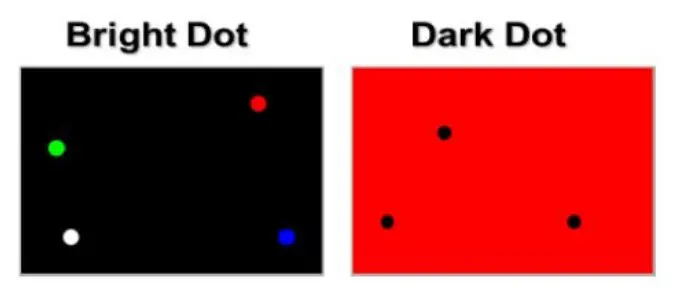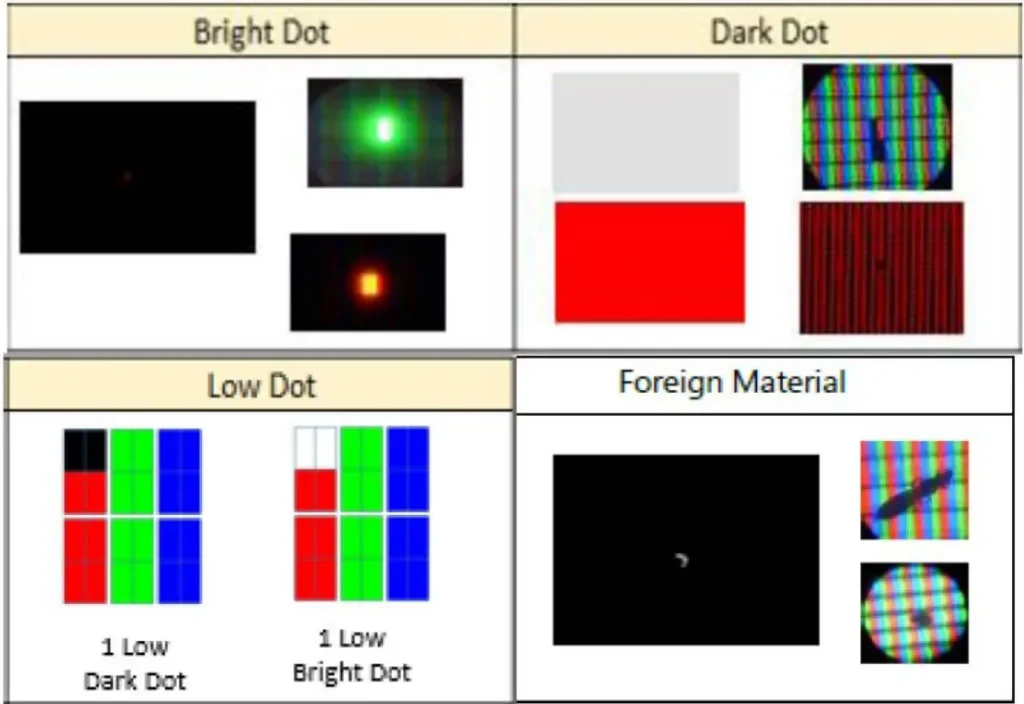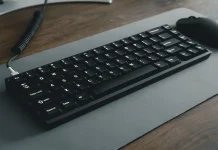The main element of the TV is the screen, and its quality determines your satisfaction with your purchase. Please be aware that not all screen defects are covered by the Samsung warranty, and in some cases a TV with acceptable pixel defects cannot be repaired.
What are the different types of defects in Samsung TV displays?
| Defect Type | Defect Characteristic | Defect Description |
|---|---|---|
| Bright Dot | Visible on a black screen | The dot glows against a dark background, indicating that the pixel is constantly active and in a working state when it should be off. |
| Dark Dot | Visible on red, green, blue, and white backgrounds | The pixel is constantly closed, even when it should be working. Diagnostic tests use primary colors: blue, red, and green. In some displays, such as OLED from LG, a fourth white color is also used. |
| Low Dot | Size less than half of a pixel | A light or dark dot that occupies less than half of a pixel. Some screens have pixels composed of two parts; the defect may affect only one of them. |
| Foreign Object | Small bright dot or dark spot of any shape | A very small bright dot or dark spot of any shape on any color or black image. This defect is caused by the presence of foreign objects, such as display trimmings or small insects. |
Detailed explanation of pixel defect (bright dot/dark dot/low dot)
- Bright Dot: This defect is characterized by the dot remaining visible against a black background. The pixels glow brightly against a dark background, indicating that they are active when they should be off. This happens because voltage is constantly applied to the pixel and it remains in an active state. This is usually due to a defect in the control elements of the display. This defect is irrecoverable and will remain on the screen forever.
- Dark Dot: In this case, the dot looks darker on red, green, blue and white backgrounds. This means that the pixel is constantly in a closed state when it should be working. Since the three standard colors – blue, green and red – are commonly used to display color, and some OLED panels manufactured by LG also have a fourth white pixel. Therefore, these colors are used for diagnosis and defect detection. This is also an unrecoverable defect of the display.

- Low Dot: A light or dark dot occupying less than half of a pixel. This indicates that some screens have a structure in which one pixel of the image consists of two parts, and only one part of the pixel may be non-functional. This is also an unrecoverable defect.

Foreign Object: This defect appears as a very small bright dot on each color or black background in the display. This is a manufacturing defect in which a foreign object, such as debris from trimming the display, gets into the layers of the display, which can short-circuit the conductors and cause the display pixel to glow brightly or, conversely, obstruct the light, in which case it will be a randomly shaped black dot, or an insect can get into the layers of the display (yes, this sometimes happens).
Samsung TV Display: Specifications for Broken Pixel Warranty
Samsung offers specialized warranty coverage for various types of pixel defects on your TV screen. Below is a comprehensive guide to the conditions that may qualify you for a replacement:
Bright Spot Defects
The warranty covers one or more bright pixels, whether they are randomly placed or clustered together. If your TV has at least one pixel that remains constantly bright, you are entitled to request a panel replacement under warranty.
Dark Spot Defects
- If five or more non-functioning pixels are randomly scattered on the screen, the panel qualifies for a replacement under warranty.
- If three or more non-functioning pixels are present on a green background, arranged randomly on the screen, the panel is covered under warranty.
- If five or more non-functioning pixels are found on a red or blue background, arranged randomly, the panel is eligible for warranty coverage.
- Two adjacent non-functioning pixels, whether aligned horizontally or vertically, within a 2 mm distance from each other, are also covered under the warranty.
Foreign Particles
If foreign particles measuring 0.5 mm or larger are found on the screen, this defect qualifies for warranty coverage.
Low Dot Defects
If there are five or more half-pixels on a gray background, and their brightness exceeds the gray background by between 0% and 25%, the defect is covered under warranty. Furthermore, if at least one pixel is 25% or more brighter than the gray background, the display is eligible for warranty replacement.
Randomly Located Broken Pixels
If broken pixels are more than 20 mm away from other defective pixels, they are considered to be randomly located. However, if three broken pixels are grouped within a 20×20 mm area on the screen, you may qualify for warranty service. In such cases, an authorized company representative will make the final decision regarding warranty eligibility. It is important to emphasize to the support team that the pixels are not randomly scattered but clustered together to ensure a proper evaluation for a replacement.
Specification table for broken pixels
| Type of Defect | Warranty Conditions | Warranty |
|---|---|---|
| Bright Spot Defects | One or more bright pixels (randomly placed or neighboring) qualify for a warranty replacement. | Warranty Case |
| Dark Spot Defects | – Five or more non-functioning pixels randomly scattered on the screen. | Warranty Case |
| – Three or more non-functioning pixels on a green background, randomly arranged. | Warranty Case | |
| – Five or more non-functioning pixels on a red or blue background, randomly arranged. | Warranty Case | |
| – Two adjacent non-functioning pixels (horizontal or vertical) within 2 mm of each other. | Warranty Case | |
| Foreign Particles | Foreign particles measuring 0.5 mm or larger qualify for warranty coverage. | Warranty Case |
| Low Dot Defects | – Five or more half-pixels on a gray background with brightness 0% to 25% higher than the gray background. | Warranty Case |
| – At least one pixel that is 25% or more brighter than the gray background. | Warranty Case | |
| Randomly Located Broken Pixels | Three broken pixels clustered within a 20×20 mm area are subject to further evaluation by an authorized representative. | Subject to Evaluation |




